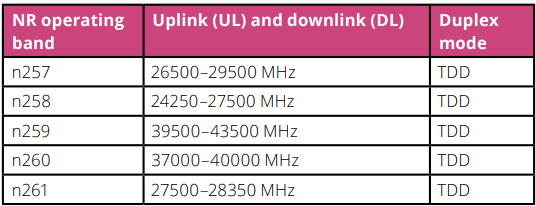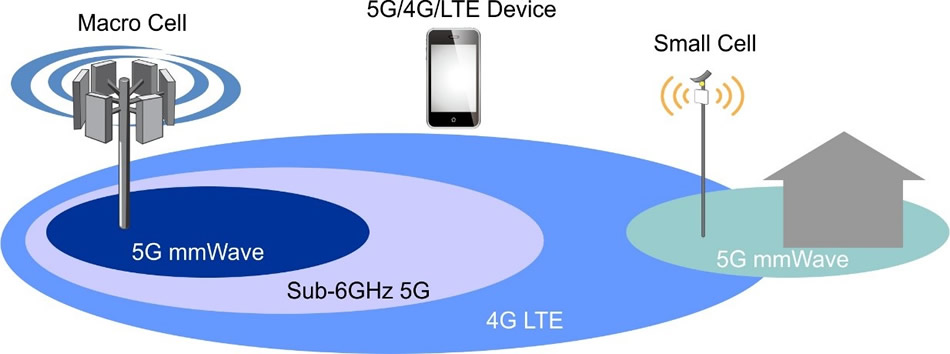Before talking about the challenges of 5G Network planning and optimization in the mmWave band, let’s start with the common question, Why we need mmWave especially for 5G technology?
History of High Frequencies in Mobile Communication
While high frequencies have been used for point-to-point network backhaul links, cellular carriers have never before made
common use of these frequencies to serve individual user devices directly. But the lack of unused spectrum available below 6 GHz, and the huge channel bandwidths available at mmWave are the main reasons for thinking of mmWave Bands.
What are the mmWave Bands?
Millimeter-wave spectrum is the band of spectrum between 30 GHz and 300 GHz. Wedged between microwave and infrared waves, this spectrum can be used for high-speed wireless communications as seen with the latest 802.11ad Wi-Fi standard (operating at 60 GHz).
The high-frequency bands in the spectrum above 24 GHz were targeted as having the potential to support large bandwidths and high data rates, ideal for increasing the capacity of wireless networks. These high-frequency bands are often referred to as “mmWave” due to the short wavelengths that can be measured in millimeters.
Although the mmWave bands extend all the way up 300 GHz, it is the bands from 24 GHz up to 100 GHz that are expected to be used for 5G. The mmWave bands up to 100 GHz are capable of supporting bandwidths up to 2 GHz, without the need to aggregate bands together for higher data throughput.

mmWave makes possible blazing 5G speeds that simply can’t be achieved in the single channels available at lower frequencies, but that performance comes with a hefty price in propagation.
The Federal Communications Commission last year held a series of three mmWave auctions that auctioned spectrum at 24 GHz, 28 GHz, upper 37 GHz, 39 and up to 47 GHz.
The Wavelength of mmWave Bands
High frequency means narrow wavelengths, and for mm waves that sits in the range of 1 millimeter to 10 millimeters. Its strength can be reduced due to vulnerabilities against gases, rain, and humidity absorption. And to make matters even less appealing, due to those factors millimeter wavelengths only reach out to a few kilometers.
In an outdoor environment, mmWave signals can be impacted by weather conditions, including snow, rain, and even fog.
The actual wavelengths of most of those “millimeter wave” frequencies are closer to a centimeter: the full wavelength size for
24 GHz is 12.5 mm, for instance, while 39 GHz is about 7.69 mm per wavelength and 47 GHz is 6.38 mm. Comparatively, one full wavelength of 600 MHz is half a meter.
mmWave wavelengths
24 GHz: 12.5 mm
28 GHz: 10.7 mm
39 GHz: 7.69 mm
47 GHz: 6.38 mm
Cellular low-band wavelengths
600 MHz: 0.5 m
700 MHz: 0.43 m
850 MHz: 0.35 m
As the spectrum goes, the higher the frequency, the greater the path loss, and therefore, the shorter the range of each
cell site.
5G mmWave Frequency Bands
At WRC-2019 in November, several new frequency ranges were identified for IMT, to be used by IMT-2020 (5G). These encompassed many of the existing 3GPP-bands plus some new spectrum ranges:

The Challenges of 5G mmWave Deployment
The high penetration losses and blocking mean that mmWave deployments will cover outdoor or indoor environments, but not provide outdoor to indoor connectivity. The mmWave cell sizes will, therefore, be smaller and higher in density. Also, it can be expected that mmWave will coexist in tight integration with 5G deployments below 6 GHz as well as 4G LTE.
Short transmission paths and high propagation losses allow for spectrum reuse by limiting the amount of interference between adjacent cells. In addition, where longer paths are desired, the extremely short wavelengths of mm-wave signals make it feasible for very small antennas to concentrate signals into highly focused beams with enough gain to overcome propagation losses. The short wavelengths of mmWave signals also make it possible to build multi-element, dynamic beamforming antennas that will be small enough to fit into handsets.

The Solution!
To compensate for higher path loss and shorter range, 5G systems are making use of beamforming and beam steering with complex antenna arrays that direct high gain beams toward user devices, either in a static grid or with more sophisticated tracking of devices.

However, the use of beamforming means that the angle at which the beams strike the device — the angle of arrival — is quite important, and the arrangement of the antennas within the user equipment is crucial as well. The difference between holding a mmWave in your right hand versus your left (depending on your orientation to the nearest base stations), or in portrait mode versus landscape mode, can make a significant difference in device performance.
5G device support for bands above 24 GHz
5G device support for spectrum bands above 24 GHz is still at an early stage. GSA’s GAMBoD database includes 84 announced
5G devices that do or will support mmWave spectrum bands, up from 59 six months ago.
- 27 of those are understood to be commercially available.
- The number of devices identified as supporting specific bands is much lower, as information about spectrum support is not always publicly available, especially for pre-commercial devices.
Possible 5G mmWave Deployment Scenarios
The International Telecommunication Union (ITU) identified three main categories for the 5G NR architecture; Enhanced Mobile Broadband (eMBB) for greater mobile capacity, Ultra-reliable and Low-latency Communications (uRLLC) for mission-critical services, and Massive Machine Type Communications (mMTC) for vast numbers of low-cost, low-energy devices (Internet of Things). These broad areas provide plenty of early deployment possibilities for 5G mmWave, such as the following:
- Fixed wireless Internet access. The Gigabit data rates of 5G mmWave could completely replace a number of Internet access technologies with hybrid fiber and wireless networks connecting subscriber homes. Although not truly a mobile system, it could provide competition to existing Wi-Fi systems that provide this type of fixed wireless access.
- Outdoor urban/suburban small cells. An expected deployment scenario for 5G mmWave would be to provide increased capacity in high-demand public spaces and venues. With cell sizes around 100m, small 5G mmWave access points can be placed on poles or buildings to provide the required coverage.
- Mission-critical control applications. Autonomous vehicles, vehicle-to-vehicle communications, drone communications, and other latency-sensitive, high-reliability applications provide other possible deployment scenarios for 5G mmWave with a projected network latency of less than a millisecond.
- Indoor hotspot cells. Shopping malls, offices, and other indoor areas require a high-density of 5G mmWave microcells. These small cells will potentially support download speeds of up to 20 Gbps, providing seamless access to cloud data and the ability to support multiple applications, as well as various forms of entertainment and multimedia.
- Internet of Things. The general connectivity of objects, sensors, appliances, and other devices for data collection, control, and analysis. Potentially could cover smart home applications, security, energy management, logistics and tracking, healthcare, and a multitude of other industrial operations.
Resources
- SurCall.com
- RCRWireless.com
- accton.com
- GSA.com
- Huawei.com
Ask Moniem
- Thanks for sending me any technical question at moniem@moniem-tech.com
mmWave Youtube Videos
